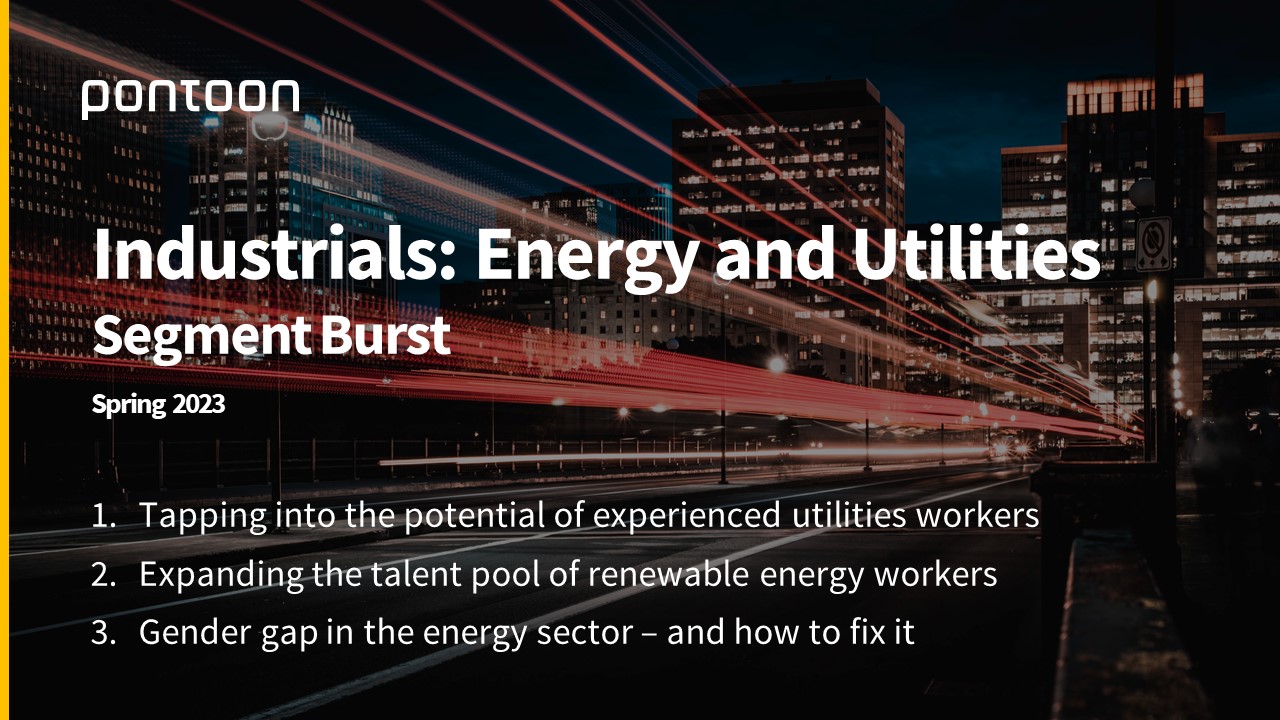Industrials Segment Burst: Spring 2023
Research
.
In the Spring 2023 volume of Industrials Segment Burst, we explore the most recent trends in the energy and utilities industry.
Tapping into the potential of experienced utilities workers
With nearly one-third of utilities workers nearing retirement age in the US and the EU alike, companies face the question of how to use the full potential of experienced talent. It’s critical that businesses leverage this wealth of expertise before it exits the workforce.
Retaining current talent is one thing, but hiring mature workers is also a valuable opportunity to ensure cross-generational knowledge transfer that can benefit your business. Making your company a welcoming place for older workers is necessary in times of increased economic uncertainty and cost-of-living crisis, as retirees across all industries are now more likely to return to the labour force for financial reasons.
A 50+ friendly workplace should not only provide legal protection from ageism but also give employees more flexibility. By independently choosing when to work and how many responsibilities to take on, mature workers can more effectively combine their professional and personal lives, adjusting their work reality to changing health needs. Care benefits are also key to ensuring that mature workers can attend to their mental and physical health and stay in the workforce for longer.
Companies also need to make sure that experienced professionals have the right opportunities and tools to share their knowledge with younger generations.
Location intelligence tools are an effective innovation that allows utilities companies to prevent brain drain related to retirement. These tools digitally gather data generated by equipment, machinery, and sensors when senior workers fulfil their daily tasks during both routine and emergency projects.
Since each mature worker has decades-long, first-hand knowledge about machinery and infrastructure, companies should use technology – further supported by mentorship programmes – to make sure this knowledge does not get lost.
Expanding the talent pool of renewable energy workers
The renewable energy sector is booming. In the US alone, there has been a 237% surge in job opportunities over the past five years. This remarkable growth highlights the massive potential of green energy jobs.
Some sources suggest that the balance between supply and demand for green skills is relatively satisfactory, but we also know that some skills are in higher demand than others. For instance, the “Renewable Energy Generation” skill appears in approx. 5% of green-skill jobs on LinkedIn. The share of users claiming to have that skill adds up to over 9% – in this case, the balance between supply and demand is good. However, according to the same study, solar energy skills display a lower prevalence in the workforce while simultaneously being in large employer demand.
These findings align with recent expert voices who say that a solar skills shortage is threatening Europe’s green energy plans. We also know that the US wind energy sector is struggling to find the right candidates.
The good news is that the current workforce is interested in transitioning to green energy jobs. However, left to its own devices, the volume of transitions will not be large enough to have a transformative impact. It is thus up to the joint efforts of national governments, private companies, and educational institutions to drive that impact.
Energy companies that reskill their workforce, facilitate training for new employees, and collaborate with schools and universities, can future-proof their business by tending to both current and future talent.
To ensure the success of their recruitment strategies, employers should focus on the prospective employees’ potential to gain the right skills. That way, companies can save the time and money that would otherwise go into the search for pre-existing skills – and these are hard to find. The talent pool will naturally become wider if transferrable skills are taken into consideration.
Attracting candidates from groups traditionally underrepresented in the sector is also key to growing the talent pool. Through more inclusive policies and better training programmes companies can, for instance, tap into the invaluable pool of female talent.
Gender gap in the energy sector – and how to fix it
Despite advancements in gender equity, outdated preconceptions about gender roles impede women’s career advancement opportunities. Gender stereotypes prevent women from pursuing degrees and careers in STEM, and the energy sector is one of the industries where the scarcity of female talent is blatantly obvious.
The sector employs 76% fewer women than men. Women hold only 32% of all roles in renewables, and they are employed mostly in administrative functions rather than in STEM and leadership roles. With the number of jobs in the energy sector projected to reach 139 million globally by 2030 (according to IRENA’s most ambitious green energy scenario), companies are now in a unique position to leverage women as agents of change who accelerate the energy transition. The net-zero transition cannot be complete without female workforce who can lend the industry their skills, expertise, and drive for a more liveable future.
Energy companies should carefully re-evaluate their hiring strategies to proactively attract and retain female talent. Adhering to diversity targets and offering training and mentorship opportunities are a must. Collaborating with universities and non-profits is an excellent way for energy companies to demonstrate their awareness of the problem and dedication to change the status quo.
Some examples of professional development groups that can potentially be leveraged include the Hungary-based non-profit Women in Energy (WONY) for Central and Eastern European talent, POWERful Women in the UK, WePOWER, dedicated to promoting STEM education among women in South Asia, or Women in Renewable Energy (WIRE), an organisation that advances the careers of female professionals in the Caribbean.
Retaining female talent in the energy sector
Bain’s research conducted in collaboration with POWERful Women UK confirms that in order to stay and advance within the sector, female employees would appreciate:
- Networking opportunities and exposure to leadership teams and particularly to women in leadership roles
- Opportunity to share and listen to career stories, especially from women with experiences of career breaks
- Transparency in internal promotion and development opportunities
- Formal and informal mentoring programmes within and outside of the organisation
Related Post
In the Winter 2023 volume of Industrials Segment Burst, we explore the most recent trends in transportation.
Global aviation industry hiring trends
In 2023, the aviation industry will be back in the ...





